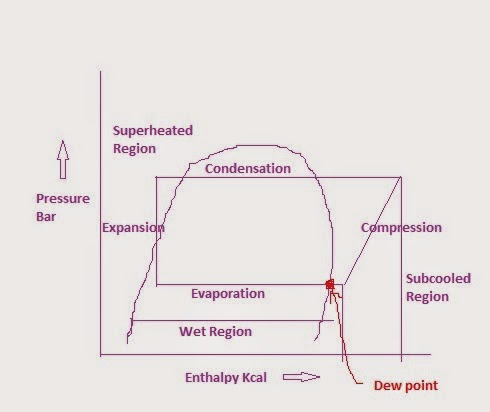Sub cooling Definition:
Sub cooling is defined as: The temperature of a liquid refrigerant when it is cooled below its condensing temperature. Sub cooling is the temperature decrease below the boiling point (same as the condensing point) in the condenser. Too high and refrigerant condenses too early in the condenser and ‘wastes’ most of the effect of the condenser. Too low and a mixture of gas and liquid can be delivered to the expansion valve, reducing efficiency.
Super heating cooling Definition:
Super heating is defined as: The temperature of vapor refrigerant above its saturation change of state (evaporation) temperature. Superheat is the temperature rise above the boiling point of the refrigerant after the evaporator. Too high, and the refrigerant boils off early in the evaporator, and ‘wastes’ most of the effect of evaporator. Too low and you risk liquid going into the compressor.
Air conditioning and refrigeration systems provide cooling (and heating) by circulating a refrigerant through a system containing a compressor, condenser, thermal expansion valve and an evaporator. The refrigerant gas is compressed, cooled and expanded to reduce its temperature and pressure, and evaporated to remove heat from living spaces or refrigeration systems. Measuring superheat and sub cooling can help you troubleshoot your refrigeration system. Improper sub cooling or superheat can indicate a variety of problems requiring you to clean or service your system
Using superheat or sub cooling is the best way to properly charge an AC/refrigeration system.
On systems with a TEV/TXV (Thermostatic Expansion Valve), measure the liquid line pressure and temperature to get actual sub cooling.
On systems using a fixed capillary restrictor, calculate superheat measuring the evaporator pressure (low-side) and pipe temperature reading to get actual superheat
Measuring Heat:
Latent heat cannot be directly measured as we can sensible heat. In order to properly adjust, troubleshoot and repair air conditioning equipment it is necessary that we understand heat and how to measure heat. Superheat and Sub cooling are both sensible heats and therefore can be measured with a thermometer. Superheat and Sub cooling are also temperature differentials. That is, each is a number of degrees a gas or liquid are above or below their saturation temperatures. It is essential that a service technician be able to accurately measure these differentials and diagnose system operation from them. A high quality, accurate electronic thermometer capable of measuring temperature differentials is almost an essential tool for the technician and highly useful to the interested homeowner.
How do I measure superheat?
Start the refrigeration system and run it for at least 10 minutes to establish steady-state temperatures. Connect the refrigerant manifold gauges to the suction service valve between the evaporator and the compressor. Connect the pipe clamp thermocouple to the suction line near the suction service valve. Connect the thermocouple to a digital thermometer.
Measure the suction line pressure using the refrigerant pressure gauge. Record this pressure and the suction line temperature from the thermometer. Use the refrigerant temperature/pressure chart to convert the pressure gauge reading to evaporator saturation temperature.
Subtract the evaporator saturation temperature from the thermocouple temperature. This difference is the system superheat. This shows the temperature rise above the bubble point temperature of the system. Review the operating specifications for your system to determine the proper superheat. Inadequate superheat can cause liquid refrigerant to return to the compressor, resulting in compressor damage. Incorrect superheat can also indicate improper refrigerant charge, thermal expansion device problems, a clogged filter-drier or a dirty condenser coil.
Importance of Super-heating:
Superheat gives an indication if the amount of refrigerant flowing into the evaporator is appropriate for the load. If the superheat is too high, then not enough refrigerant is being fed resulting in poor refrigeration and excess energy use. If the superheat is too low, then too much refrigerant is being fed possibly resulting in liquid getting back to the compressor and causing compressor damage.
Superheat is telling you what is going on in the evaporator.
High Superheat = Starved Evaporator
Low Superheat = Flooded Evaporator
How do I measure Sub cooling?
Measure the condenser pressure at the service valve by reading the pressure on the refrigerant manifold gauges. Read the thermocouple temperature on the digital thermometer. Use the refrigerant pressure/temperature chart to convert the pressure reading to the condenser saturation temperature.
Subtract the condenser saturation temperature from the thermocouple temperature. This is the amount of sub cooling. Inadequate sub cooling can result from a variety of problems, including inadequate airflow over the condenser, insufficient refrigerant charge, or problems with the thermal expansion valve.
Importance of Sub cooling:
Sub cooling is beneficial because it prevents the liquid refrigerant from changing to a gas before it gets to the evaporator. Pressure drops in the liquid piping and vertical risers can reduce the refrigerant pressure to the point where it will boil or "flash" in the liquid line. This change of phase causes the refrigerant to absorb heat before it reaches the evaporator. Inadequate sub cooling prevents the expansion valve from properly metering liquid refrigerant into the evaporator, resulting in poor system performance.
Sub Cooling is telling you what is going on in the condenser.
High Sub Cooling = Flooded Condenser
Low Sub Cooling = Starved Condenser
How to charge unit by sub cooling?
When your gauge set is attached to the unit, the “head” or liquid pressure you read is the saturated liquid temperature/pressure. Knowing this, and the manufacturer’s recommended sub cooling, you can properly charge the unit. You need to strap a thermometer or thermocouple to the liquid line outside the condenser so you can read its temperature and then add or remove charge to get the desired sub cooling for that unit.
